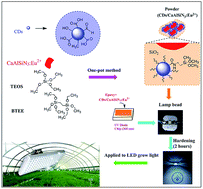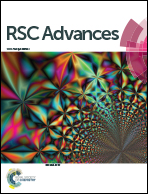A dual-emitting core–shell carbon dot–silica–phosphor composite for LED plant grow light†
Abstract
Light-emitting diodes (LEDs) are widely used for artificial lighting in plant factories and have been applied for disease prevention and for accelerating plant growth. In this study, a unique dual-emitting core–shell CDs/CaAlSiN3:Eu2+-silica powder was prepared by a one-pot sol–gel method. LED devices with multi-wavelength emission (623 nm red light and 465 nm blue light) were fabricated using the as-prepared dual-emitting core–shell CDs/CaAlSiN3:Eu2+-silica powder, and the electrical characteristics of these LED devices were evaluated. Furthermore, it was demonstrated that these LED devices could be used for plant growth lighting in plant factories. The LEDs prepared in the present study for plant growth lighting have the advantage of being convenient, low-cost, non-toxic, and stable compared with traditional LED devices for plant growth lighting.



 Please wait while we load your content...
Please wait while we load your content...